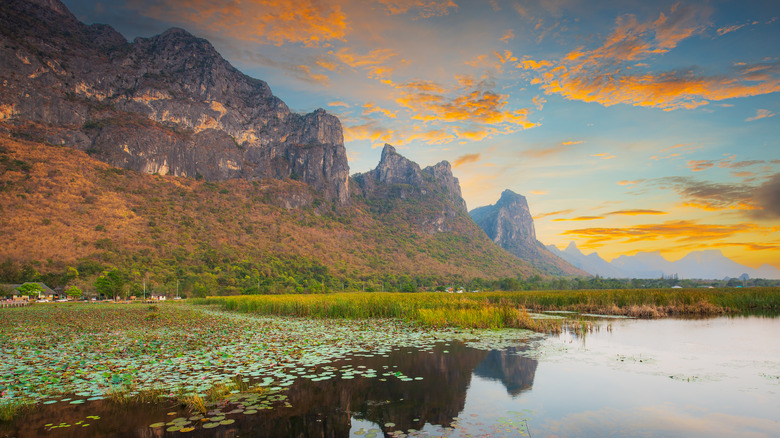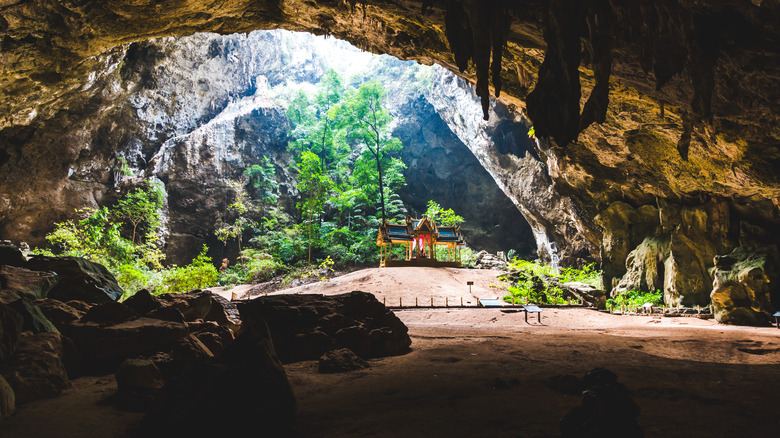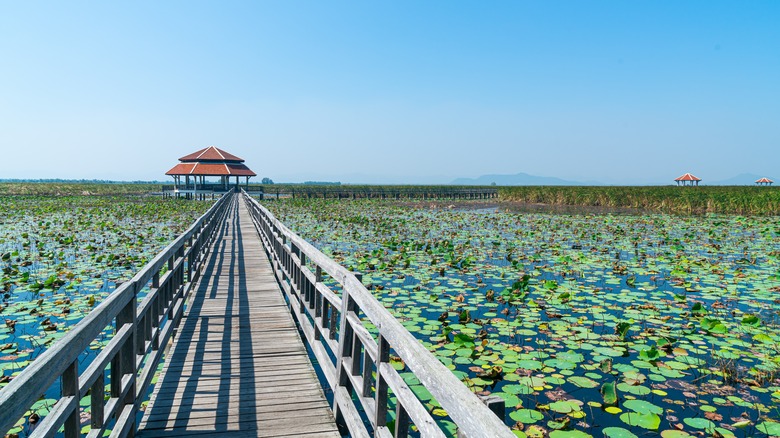Unforgettable Adventures Await In Thailand's Coastal Haven Of Beaches And Vibrant Ecosystems
Although Thailand has many hidden gem national parks, Khao Sam Roi Yot is the country's first and oldest marine national park. It's an eclectic destination renowned for its white sand beaches, jagged mountains, otherworldly cave systems, and diverse wildlife. Established as a national park in 1966, Khao Sam Roi Yot is known as "mountains with 300 peaks." According to local lore, a Chinese merchant ship crashed nearby, and 300 survivors sought refuge. Hence, the area became known as Sam Roi Yot in Thai — roughly translated to "300 survived."
This heavenly gem is about a three-and-a-half-hour drive south of Bangkok, in Prachuap Khiri Khan province, which borders Myanmar on one side and the Gulf of Thailand on the other. After landing in Bangkok, hire a car or take a train to the charming resort town of Hua Hin. Formerly a fishing village, Hua Hin is a worthy pitstop before heading to Khao Sam Roi. You can spend the day sunbathing at the three-mile stretch of white sand beach at Hua Hin Beach, sampling award-winning vinos at Monsoon Valley Vineyard, and shopping for handmade crafts at the vibrant Cicada Market. Then, rent a car and head to Khao Sam Roi Yot, about an hour away.
For the best experience, we recommend visiting the national park during its dry season, which runs from December to April. The park's wet season is from May to November, with the most rainfall between September and November.
Descend to one of Thailand's most famous caves
Phraya Nakhon Cave is the crown jewel of Khao Sam Roi Yot. It is equally famous for the lone pavilion inside a stone vault and the arduous expedition to get there. Start your journey early in the morning from the small sea town of Bang Pu to Laem Sala Beach, where you begin your trek to the renowned cave. It's a 30-minute hike or a 200 THB ferry ride to the beach.
Once you get there, you will most likely be distracted by the little-known Thai island beach with imposing limestone cliffs, pristine white sand, and crystal-clear azure water. We recommend enjoying Laem Sala Beach more thoroughly on your way back from the Phraya Nakhon Cave since you don't want to miss the cave at its most majestic during the golden hour at around 10:30 a.m. Pay the national park fee of 200 THB and look for the sign that marks the start of the hike. The trek is not for the faint-hearted—it involves a 920-foot straight uphill battle of rocks and uneven steps. Be sure to pack some water and wear appropriate footwear!
Your reward is an awe-inspiring underground canyon discovered over 200 years ago by Chao Praya Nakhon Sri Thammarat, a governor and a son of King Taksin. He stumbled upon this mystical spot while seeking shelter from a storm. The epicenter of this natural magnificence is the Kuha Karuhas Pavilion, an elegant gold and green structure built in 1890 to commemorate King Rama V's visit. The pavilion, surrounded by huge boulders and sparse greenery, appears magical as the late morning sunlight saturates it in golden rays.
A birdwatcher and nature lover's paradise
Check out the gorgeous, sprawling Thung Sam Roi Yot, a freshwater and brackish water swamp in the northwest corner of the mountain range. Experience the stunning "Red Lotus Sea" from the first week of January to the end of March when blooming pink lotus flowers adorn the swamp's surface. To take in the 360-degree scenery of the wetland surrounded by majestic mountains, stroll to the octagonal pagoda via the wooden boardwalk cutting through the marsh or rent a small boat to glide along the water.
Like the best birdwatching destinations in the U.S., the best time to visit Thung Sam Roi Yot for birding is early in the morning or at sunset, as you are more likely to see the most variety of birds. Keep your eye out for migratory waterbirds, like Swinhoe's snipe, jack snipe, and other rare birds traveling between Asia and Australia. If you're lucky, you might even spot the round-headed Irrawaddy dolphins off the coast. The goofy-looking mammals look like a beluga but are more related to the orca. You might also see some local residents of the national park, such as the fishing cat, a feral feline living in mangroves, the dusky leaf monkey, a grey-haired primate, and the Malayan porcupine, the spiky rodent.
Cap off your visit to the national park by hiking to the Khao Daeng Viewpoint for a fantastic panoramic view. This is where you can truly appreciate the park's diversity, from crags to marshland to the forest and the coast. It's a relatively easy hike for a spectacular view, and you'll walk away with postcard-worthy photographs.


